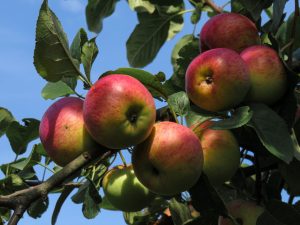 Yog koj cog cov noob txiv tshiab hnub no, you’ll probably have to wait about seven years before your tree grows fruit. Thaum nws ua li nws, Txawm li cas los, it can produce for decades.
Yog koj cog cov noob txiv tshiab hnub no, you’ll probably have to wait about seven years before your tree grows fruit. Thaum nws ua li nws, Txawm li cas los, it can produce for decades.
That’s a perennial payoff, but farmers like me don’t enjoy this option. We grow annuals. Our crops live for a single season. For the most part, this is what we do: Plant, harvest, repeat.
But what if our crops were to last longer? What if we could extend their lives and production capability beyond a year?
This is the Holy Grail of wheat research: For more than a century, scientists have tried to develop a variety of wheat that produces grain in consecutive seasons.
Wheat is already one of the hardiest crops on the planet. That’s why I grow it on my farm in the Western Canadian province of Saskatchewan. It’s perfect for our harsh conditions: Wheat can withstand a bad drought, live through extreme rainfall, and survive in the brutal cold. It’s the most resilient crop we grow.
Yet it’s not our only crop. We also produce canola, lentils, peas, and flax. This diversity is good for us. It broadens our rotation, benefits our soil, and improves our risk management. By relying on several crops, we’ve reduced the risk of weeds, nyob rau ntau xyoo, and diseases. Consumers benefit from these results because they lead to more abundant and affordable food.
 Wheat is no longer our region’s largest crop in terms of dollars by production, but it’s a fundamental part of our operation. It’s our most traditional staple crop and we ship it around the world: Wheat from my farm can wind up in pasta, bread, and cookies in places like North Africa, Ltalis, Nyiv, and Turkey. Our agricultural economy depends on selling this crop in these export markets.
Wheat is no longer our region’s largest crop in terms of dollars by production, but it’s a fundamental part of our operation. It’s our most traditional staple crop and we ship it around the world: Wheat from my farm can wind up in pasta, bread, and cookies in places like North Africa, Ltalis, Nyiv, and Turkey. Our agricultural economy depends on selling this crop in these export markets.
I simply can’t imagine farming without wheat.
Now modern science allows me to imagine a revolution in wheat farming: The possibility of breaking the annual cycle and growing a crop that lives for more than a year.
Researchers at the Land Institute and elsewhere are working hard to turn this longstanding dream of wheat farmers into a reality. The research involves crossbreeding annual wheat crops with species of wheatgrass, with the goal of creating an improved wheat that can provide additional benefits to farmers and consumers.
The potential advantages of perennial wheat are incredible. It would reduce the acres we have to seed each spring, dramatically reducing the capital spent on fuel, tshuab, and labor and thereby lowering the cost of production. It also would outcompete annual weeds, develop extensive root systems for drawing water and nutrients, and possibly be grazed by cattle and other kinds of livestock. Finally, it would fight climate change by sequestering enormous amounts of carbon, due to the years without tillage or planting and the full-season growth it would employ, pulling it out of the atmosphere and storing it in the soil.
The challenge for perennial wheat is economic sustainability. The latest prototypes yield about 50 rau 70 percent of what we can currently harvest from spring wheat. This is good but not good enough: I figure that if a perennial wheat can produce reliably at a rate of 70 lossis 80 feem pua, it might be feasible on my farm, provided that the seeds are functional for developing food and baking products.
Nyob rau hauv tas li ntawd, it would have to do this consistently: If perennial wheat were to produce at 80 percent in the first year and then drop down to 30 percent in the second and third year, it would not work. It would have to perform at a high level across seasons.
Those are big demands, but wheat farming is a big job. In the world’s wheat market, we compete with Russia, the United States, Australia, the EU, and some of the former Soviet Union countries like Ukraine and Kazakhstan.
 The good news is that scientists are working on the problem, and they’re motivated by tremendous economic and environmental benefits.
The good news is that scientists are working on the problem, and they’re motivated by tremendous economic and environmental benefits.
That makes me hopeful about the future of perennial wheat. We’ve already seen so many technological advancements in agriculture, from the boon of genetic modification to the advent of GPS-powered equipment.
Many familiar crops are in fact perennials—not just apples and other fruit trees, but alfalfa, asparagus, thiab ntau.
Why not wheat?
Nyem no kom xa nyiaj mus rau Cov Neeg Ua Haujlwm Pab Nyiaj rau ntiaj teb.
To learn more about how the GFN empowers farmers to share ideas through a strong voice, click ntawm no.

